The Works of Charles Wesley (22 vols.)
Digital Logos Edition
Overview
One of the principle founders of the Methodist movement with his brother John Wesley, Charles Wesley was also a gifted preacher, orator, and hymnist. In fact, Wesley is said to have penned over 6,000 hymns! Many of these hymns are still used today—including “Hark! The Herald Angels Sing,” “Christ the Lord Is Risen Today,” “Love Divine, All Loves Excelling,” and “Soldiers of Christ, Arise.”
The Works of Charles Wesley (22 vols.) brings together all of Charles’ most important writings, including:
- G. Osborn’s 13 volume Poetical Works of John and Charles Wesley
- Thousands of Charles Wesley’s greatest hymns
- The much loved Short Hymns on Select Passages of the Holy Scriptures, Charles’ poetic commentary on the Old and New Testaments
- The two-volume collected journals of Charles Wesley
- Sermons of the Late Rev. Charles Wesley
- John Telford and Thomas Jackson’s biographies of Charles Wesley
- And much, much more!
This is the most complete collection of Charles Wesley’s writings available in print or electronically! What’s more, the Logos edition makes The Works of Charles Wesley (22 vols.) more widely available and easier to access than ever! From the countless Scripture references linked straight to the biblical text, to the powerful search tools in your digital library, the Logos edition lets you encounter Wesley like never before. Logos also makes navigating lengthy, multivolume works easier than ever—such as the 13 volume Poetical Works of John and Charles Wesley or his massive catalog of hymns and poems. The Works of Charles Wesley (22 vols.) is a must have for pastors, teachers, and anyone interested in studying the works of the “sweet singer” of Methodism.

- Contains Short Hymns on Select Passages of the Holy Scriptures
- Examines thousands of Charles Wesley’s greatest hymns
- Includes in-depth biographies
- Provides material that is completely searchable by topic or Scripture reference
- Title: The Works of Charles Wesley
- Volumes: 22
- Pages: 8,837
This title is included in the following collections
You can save when you purchase this product as part of a collection.
2025 Wesleyan Silver
$349.99$297.49Logos 8 Methodist & Wesleyan S...
$349.99$349.99Methodist & Wesleyan Library B...
$459.99$459.992025 Wesleyan Gold
$849.99$722.49
- $849.99
- $849.99
- $849.99
- $849.99
- $849.99
- $849.99
- $849.99
- $1,499.99$1,274.99
- $1,499.99
- $1,499.99
- $1,499.99
- $1,499.99
- $1,499.99
- $1,499.99
- $2,999.99$2,549.99
- $2,999.99
- $2,999.99
- $2,999.99
- $2,999.99
- $2,999.99
- $2,999.99
- $2,999.99
- $4,749.99$4,037.49
- $4,749.99
- $4,749.99
- $4,749.99
- $4,749.99
- $11,399.99
- $11,399.99
- $11,399.99
- $23,999.99$20,399.99
- $21,749.99
- $24,999.99
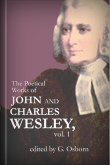
The poetical publications of John and Charles Wesley originally appeared at various intervals during a span of 53 years. George Osborn has collected, arranged, and provided notes for all of these important poems and hymns. Many of these works, especially those of Charles Wesley’s (whose work makes up the bulk of this collection), were never before published or published anonymously. Charles Wesley was the author of more than 6,000 hymns, and today, more than 500 hymns of John and Charles Wesley are in common use in various hymnals.
Volume one contains:
- Hymns and Sacred Poems, 1739
- Hymns and Sacred Poems, 1740
- Index to the First Lines
The Wesley poetry has stood the test of time, and is more in demand than it was 100 years ago. The volume is enriched by original notes, brief but illustrative; it is adorned with a beautiful portrait of the Rev. Charles Wesley, and it contains facsimiles of the old title-pages; which, together with the table of contents, the index, the headings to each poem and to every page, and the original prefaces and notes, give a completeness to the book we do not expect to see surpassed.
—The London Quarterly Review
George Osborn (1808–1891) was a Methodist minister and a professor of divinity at Richmond College from 1868–1885. A noted expository preacher and a founding member of the Evangelical Alliance, Osborn also penned the two-volume Outlines of Wesleyan Bibliography.
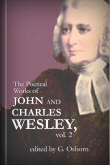
The poetical publications of John and Charles Wesley originally appeared at various intervals during a span of 53 years. G. Osborn has collected, arranged, and provided notes for all of these important poems and hymns. Many of these works, especially those of Charles Wesley’s (whose work makes up the bulk of this collection), were never before published or published anonymously. Charles Wesley was the author of more than 6,000 hymns, and today, more than 500 hymns of John and Charles Wesley are in common use in various hymnals.
Volume two contains:
- A Collection of Psalms and Hymns, 1741
- Hymns and Sacred Poems, 1742
- Index to the First Lines
George Osborn (1808–1891) was a Methodist minister and a professor of divinity at Richmond College from 1868–1885. A noted expository preacher and a founding member of the Evangelical Alliance, Osborn also penned the two-volume Outlines of Wesleyan Bibliography.
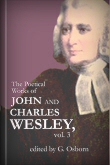
The poetical publications of John and Charles Wesley originally appeared at various intervals during a span of 53. G. Osborn has collected, arranged, and provided notes for all of these important poems and hymns. Many of these works, especially those of Charles Wesley’s (whose work makes up the bulk of this collection), were never before published or published anonymously. Charles Wesley was the author of more than 6,000 hymns, and today, more than 500 hymns of John and Charles Wesley are in common use in various hymnals.
Volume three contains:
- Hymns on God’s Everlasting Love (First Series)
- Hymns on God’s Everlasting Love (Second Series)
- Original Poems
- Hymns on the Lord’s Supper
- Gloria Patri; or, Hymns to the Trinity
- Graces
- Index to the First Lines
George Osborn (1808–1891) was a Methodist minister and a professor of divinity at Richmond College from 1868–1885. A noted expository preacher and a founding member of the Evangelical Alliance, Osborn also penned the two-volume Outlines of Wesleyan Bibliography.
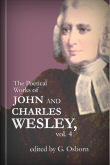
The poetical publications of John and Charles Wesley originally appeared at various intervals during a span of 53 years. G. Osborn has collected, arranged, and provided notes for all of these important poems and hymns. Many of these works, especially those of Charles Wesley’s (whose work makes up the bulk of this collection), were never before published or published anonymously. Charles Wesley was the author of more than 6,000 hymns, and today, more than 500 hymns of John and Charles Wesley are in common use in various hymnals.
Volume four contains:
- Hymns for Times of Trouble and Persecution
- Hymns in Times of Persecution
- Hymns to Be Sung in a Tumult
- Hymns for Times of Trouble, for the Year 1745
- Hymns for Times of Trouble
- Hymns for the Public Thanksgiving Day, October 9, 1746
- Hymns for the Nativity of Our Lord
- Hymns for Our Lord’s Resurrection
- Hymns for Ascension-Day
- Hymns of Petition and Thanksgiving for the Promise of the Father
- Hymns for Those That Seek and Those That Have Found Redemption in the Blood of Jesus Christ
- Hymns and Sacred Poems, vol. 1, part 1
- Index to the First Lines
George Osborn (1808–1891) was a Methodist minister and a professor of divinity at Richmond College from 1868–1885. A noted expository preacher and a founding member of the Evangelical Alliance, Osborn also penned the two-volume Outlines of Wesleyan Bibliography.
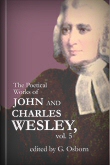
The poetical publications of John and Charles Wesley originally appeared at various intervals during a span of 53 years. G. Osborn has collected, arranged, and provided notes for all of these important poems and hymns. Many of these works, especially those of Charles Wesley’s (whose work makes up the bulk of this collection), were never before published or published anonymously. Charles Wesley was the author of more than 6,000 hymns, and today, more than 500 hymns of John and Charles Wesley are in common use in various hymnals.
Volume five contains:
- Hymns and Sacred Poems, vol. 1, part 2
- Hymns and Sacred Poems, vol. 2, part 1
- Hymns and Sacred Poems, vol. 2, part 2
- Index to the First Lines
George Osborn (1808–1891) was a Methodist minister and a professor of divinity at Richmond College from 1868–1885. A noted expository preacher and a founding member of the Evangelical Alliance, Osborn also penned the two-volume Outlines of Wesleyan Bibliography.
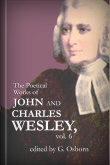
The poetical publications of John and Charles Wesley originally appeared at various intervals during a span of 53 years. G. Osborn has collected, arranged, and provided notes for all of these important poems and hymns. Many of these works, especially those of Charles Wesley’s (whose work makes up the bulk of this collection), were never before published or published anonymously. Charles Wesley was the author of more than 6,000 hymns, and today, more than 500 hymns of John and Charles Wesley are in common use in various hymnals.
Volume six contains:
- Hymns for a Protestant
- Hymns for New Year’s Day, 1750
- Hymns Occasioned by the Earthquake, March 8, 1750, part 1
- Hymns Occasioned by the Earthquake, March 8, 1750, part 2
- An Epistle to the Reverend Mr. John Wesley
- An Epistle to the Reverend Mr. George Whitefield
- Hymns for the Year 1756, Particularly for the Fast-Day, February 6
- Hymns for the Preachers among the Methodist (So-Called)
- Hymns of Intercession for All Mankind
- Hymns on the Expected Invasion, 1759, and for the Thanksgiving Day
- Hymns to Be Used on the Thanksgiving Day and After It
- Funeral Hymns
- Hymns for Children
- Index to the First Lines
George Osborn (1808–1891) was a Methodist minister and a professor of divinity at Richmond College from 1868–1885. A noted expository preacher and a founding member of the Evangelical Alliance, Osborn also penned the two-volume Outlines of Wesleyan Bibliography.
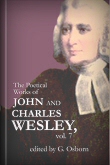
The poetical publications of John and Charles Wesley originally appeared at various intervals during a span of 53 years. G. Osborn has collected, arranged, and provided notes for all of these important poems and hymns. Many of these works, especially those of Charles Wesley’s (whose work makes up the bulk of this collection), were never before published or published anonymously. Charles Wesley was the author of more than 6,000 hymns, and today, more than 500 hymns of John and Charles Wesley are in common use in various hymnals.
Volume seven contains:
- Hymns for the Use of Families, and on Various Occasions
- Hymns on the Trinity
- Preparation for Death, in Several Hymns
- An Elegy on the Late Rev. George Whitefield
- Index to the First Lines
George Osborn (1808–1891) was a Methodist minister and a professor of divinity at Richmond College from 1868–1885. A noted expository preacher and a founding member of the Evangelical Alliance, Osborn also penned the two-volume Outlines of Wesleyan Bibliography.
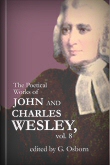
The poetical publications of John and Charles Wesley originally appeared at various intervals during a span of 53 years. G. Osborn has collected, arranged, and provided notes for all of these important poems and hymns. Many of these works, especially those of Charles Wesley’s (whose work makes up the bulk of this collection), were never before published or published anonymously. Charles Wesley was the author of more than 6,000 hymns, and today, more than 500 hymns of John and Charles Wesley are in common use in various hymnals.
Volume eight contains:
- Versions and Paraphrases of Select Psalms
- Hymns Written in the Time of the Tumults, June 1780
- Hymns for the Nation, in 1782
- Hymns for the National Fast
- Prayers for Condemned Malefactors
- Hymns for Love
- Hymns and Poems
- Epitaphs
- Miscellaneous Hymns and Poems
- Index to the First Lines
George Osborn (1808–1891) was a Methodist minister and a professor of divinity at Richmond College from 1868–1885. A noted expository preacher and a founding member of the Evangelical Alliance, Osborn also penned the two-volume Outlines of Wesleyan Bibliography.
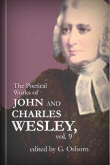
The poetical publications of John and Charles Wesley originally appeared at various intervals during a span of 53 years. G. Osborn has collected, arranged, and provided notes for all of these important poems and hymns. Many of these works, especially those of Charles Wesley’s (whose work makes up the bulk of this collection), were never before published or published anonymously. Charles Wesley was the author of more than 6,000 hymns, and today, more than 500 hymns of John and Charles Wesley are in common use in various hymnals.
Volume nine contains:
- Short Hymns on Select Passages of the Holy Scriptures, part 1: Genesis–Isaiah
Charles Wesley’s Short Hymns on Select Passages of the Holy Scriptures contains over 2,000 short hymns on selected Bible passages. This sought after poetic-commentary covers the Old and New Testaments.
The interest which attaches to the Wesleyan poetry is not due merely to its intrinsic excellence. They groan under the mortal anguish of repentance; they throb and quiver with the throes of the new birth; they swell with the triumphs of faith, the full glories of a present salvation. The whole vitality, not only of the poet, but of his people and the Lord’s, is in them.
—Bibliotheca Sacra and Theological Review
George Osborn (1808–1891) was a Methodist minister and a professor of divinity at Richmond College from 1868–1885. A noted expository preacher and a founding member of the Evangelical Alliance, Osborn also penned the two-volume Outlines of Wesleyan Bibliography.
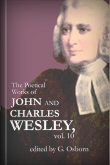
The poetical publications of John and Charles Wesley originally appeared at various intervals during a span of 53 years. G. Osborn has collected, arranged, and provided notes for all of these important poems and hymns. Many of these works, especially those of Charles Wesley’s (whose work makes up the bulk of this collection), were never before published or published anonymously. Charles Wesley was the author of more than 6,000 hymns, and today, more than 500 hymns of John and Charles Wesley are in common use in various hymnals.
Volume ten contains:
- Short Hymns on Select Passages of the Holy Scriptures, part 2: Jeremiah–Mark
Charles Wesley’s Short Hymns on Select Passages of the Holy Scriptures contains over 2,000 short hymns on selected Bible passages. This sought-after, poetic commentary covers the Old and New Testaments.
George Osborn (1808–1891) was a Methodist minister and a professor of divinity at Richmond College from 1868–1885. A noted expository preacher and a founding member of the Evangelical Alliance, Osborn also penned the two-volume Outlines of Wesleyan Bibliography.
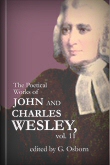
The poetical publications of John and Charles Wesley originally appeared at various intervals during a span of 53 years. G. Osborn has collected, arranged, and provided notes for all of these important poems and hymns. Many of these works, especially those of Charles Wesley’s (whose work makes up the bulk of this collection), were never before published or published anonymously. Charles Wesley was the author of more than 6,000 hymns, and today, more than 500 hymns of John and Charles Wesley are in common use in various hymnals.
Volume 11 contains:
- Short Hymns on Select Passages of the Holy Scriptures, part 2: Mark–John
Charles Wesley’s Short Hymns on Select Passages of the Holy Scriptures contains over 2,000 short hymns on selected Bible passages. This sought-after, poetic commentary covers the Old and New Testaments.
George Osborn (1808–1891) was a Methodist minister and a professor of divinity at Richmond College from 1868–1885. A noted expository preacher and a founding member of the Evangelical Alliance, Osborn also penned the two-volume Outlines of Wesleyan Bibliography.
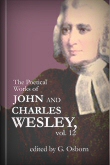
The poetical publications of John and Charles Wesley originally appeared at various intervals during a span of 53 years. G. Osborn has collected, arranged, and provided notes for all of these important poems and hymns. Many of these works, especially those of Charles Wesley’s (whose work makes up the bulk of this collection), were never before published or published anonymously. Charles Wesley was the author of more than 6,000 hymns, and today, more than 500 hymns of John and Charles Wesley are in common use in various hymnals.
Volume 12 contains:
- Short Hymns on Select Passages of the Holy Scriptures, part 3: John–Acts
Charles Wesley’s Short Hymns on Select Passages of the Holy Scriptures contains over 2,000 short hymns on selected Bible passages. This sought-after, poetic commentary covers the Old and New Testaments.
George Osborn (1808–1891) was a Methodist minister and a professor of divinity at Richmond College from 1868–1885. A noted expository preacher and a founding member of the Evangelical Alliance, Osborn also penned the two-volume Outlines of Wesleyan Bibliography.
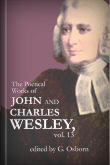
The poetical publications of John and Charles Wesley originally appeared at various intervals during a span of 53 years. G. Osborn has collected, arranged, and provided notes for all of these important poems and hymns. Many of these works, especially those of Charles Wesley’s (whose work makes up the bulk of this collection), were never before published or published anonymously. Charles Wesley was the author of more than 6,000 hymns, and today, more than 500 hymns of John and Charles Wesley are in common use in various hymnals.
Volume thirteen contains:
- Short Hymns on Select Passages of the Holy Scriptures, part 4: Romans–Revelation
- Appendix—Containing Hymns and Poems from Various Sources
- Chronological List of the Poetical Works of John and Charles Wesley Reprinted in These Volumes
Charles Wesley’s Short Hymns on Select Passages of the Holy Scriptures contains over 2,000 short hymns on selected Bible passages. This sought-after, poetic commentary covers the Old and New Testaments.
George Osborn (1808–1891) was a Methodist minister and a professor of divinity at Richmond College from 1868–1885. A noted expository preacher and a founding member of the Evangelical Alliance, Osborn also penned the two-volume Outlines of Wesleyan Bibliography.
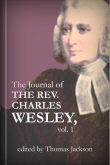
The Journal of the reverend Charles Wesley begins in 1736, with Charles Wesley’s arrival at Frederica, a month after the brothers “first set foot on American ground.” A stirring account of colonial life, these journals provide a picture of his difficulties in Georgia, the happy scenes of Whit Week 1738, the first days of the Evangelical Revival with the triumphs of the field preaching, the perils of the mob, and the gradual spread of Methodism. Includes selections from his correspondence and poetry. Volume 1 covers the years 1736–1747.
Thomas Jackson (1783–1873) joined the Methodist society in 1801 and from 1804–1824 he was an itinerant in the Wesleyan connection, occupying important circuits. He was professor of divinity in the Theological College at Richmond from 1842–1861. Jackson was the author and editor of numerous works, including The Life of John Goodwin, Memoirs of the Life and Writings of the Rev. Richard Watson, A Library of Christian Biography, and The Institutions of Christianity.
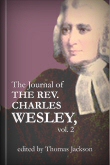
The Journal of the Rev. Charles Wesley begins in 1736, with Charles Wesley’s arrival at Frederica, a month after the brothers “first set foot on American ground.” A stirring account of colonial life, these journals provide a picture of his difficulties in Georgia, the happy scenes of Whit Week 1738, the first days of the Evangelical Revival with the triumphs of the field preaching, the perils of the mob, and the gradual spread of Methodism. Includes selections from his correspondence and poetry. Volume 2 covers the years 1748–1756.
Thomas Jackson (1783–1873) joined the Methodist society in 1801 and from 1804–1824 he was an itinerant in the Wesleyan connection, occupying important circuits. He was professor of divinity in the Theological College at Richmond from 1842–1861. Jackson was the author and editor of numerous works, including The Life of John Goodwin, Memoirs of the Life and Writings of the Rev. Richard Watson, A Library of Christian Biography, and The Institutions of Christianity.
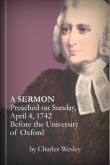
A Sermon Preached on Sunday, April 4, 1742, Before the University of Oxford
- Author: Charles Wesley
- Publisher: W. Strahan
- Publication Date: 1742
- Pages: 29
This volume contains Charles Wesley’s stirring sermon on Ephesians 5:14.
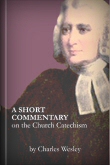
In writing this commentary on the Catechism, Charles Wesley has endeavored to produce a succinct work from which young Christians would find important instruction and easy reference to the most important questions and doctrines of their faith. For each question and answer, Wesley provides the relevant Scripture. At the end of the commentary, Wesley also provides examination questions for self study and reflection.
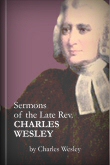
In the eighteenth century, traveling from place to place and preaching in the open air was extraordinary and new, and it was certainly irregular. Seeking to diffuse knowledge and awaken a sense of religion in the common people, brothers John and Charles Wesley, along with their friend and fellow preacher George Whitefield, excited the astonishment as well as the censure of the public with their preaching.. They felt it was of utmost importance to educate the common people in the principles of religion and the social duties of life—even if it meant preaching the Word in open-air fields against tradition. Sermons of the Late Rev. Charles Wesley brings together 13 of Charles’ best sermons, each characterized with his poetic style and spirit-filled love for God.
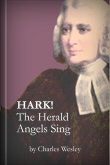
Hark! The Herald Angels Sing
- Author: Charles Wesley
- Publisher: K. P. Dutton and Company
- Publication Date: 1889
- Pages: 30
K. P. Dutton and Company produced this beautiful pairing of Charles Wesley’s beloved hymn “Hark! The Herald Angel Sings” with illustrations from some of history’s greatest artists, including Raphael, Carlo Dolci, Sir Joshua Reynolds, and more.
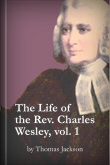
Thomas Jackson’s The Life of the Rev. Charles Wesley is a comprehensive and faithful record of the life of remarkable preacher and poet Charles Wesley. Jackson intertwines the rise and progress of Methodism while providing a complete account of Charles’ life and writings. Includes personal letters, poems, hymns, historical documents, sermons, essays, and more.
Mr. Jackson may be called, in an especial manner, the historian of Methodism, and is probably one of the best-read and most useful men in the connexion.
—The Church of England Quarterly Review
Thomas Jackson (1783–1873) joined the Methodist society in 1801 and from 1804–1824 he was an itinerant in the Wesleyan connection, occupying important circuits. He was professor of divinity in the Theological College at Richmond from 1842–1861. Jackson was the author and editor of numerous works, including The Life of John Goodwin, Memoirs of the Life and Writings of the Rev. Richard Watson, A Library of Christian Biography, and The Institutions of Christianity.
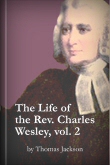
Thomas Jackson’s The Life of the Rev. Charles Wesley is a comprehensive and faithful record of the life of remarkable preacher and poet Charles Wesley. Jackson intertwines the rise and progress of Methodism while providing a complete account of Charles’ life and writings. Includes personal letters, poems, hymns, historical documents, sermons, essays, and more.
Thomas Jackson (1783–1873) joined the Methodist society in 1801 and from 1804–1824 he was an itinerant in the Wesleyan connection, occupying important circuits. He was professor of divinity in the Theological College at Richmond from 1842–1861. Jackson was the author and editor of numerous works, including The Life of John Goodwin, Memoirs of the Life and Writings of the Rev. Richard Watson, A Library of Christian Biography, and The Institutions of Christianity.
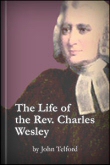
John Telford’s The Life of the Rev. Charles Wesley is an in-depth look at Charles Wesley’s life and the impact he had on the world. The biography brings the reader into contact with a wide and distinguished circle connected by friendship and admiration for Charles Wesley, with tributes from Isaac Watts, John Fletcher, Robert Southey, and more.
For popular use Mr. Telford’s biography of Charles Wesley has no competitor. One of the merits of the book is the just prominence given to his itinerant and evangelistic labors.
—The London Quarterly Review
John Telford (1851–1936) was educated at London University and was the editor for the Wesleyan Methodist Magazine. His numerous works include Life of John Wesley, The Story of Moses and Joshua: Its Lessons for Today, Women in the Mission Field, History of Lay Preaching in the Christian Church, and Man’s Partnership with Divine Providence.
Charles Wesley (1707–1788) and his brother, John Wesley, were the principle leaders of the Methodist movement. Son of Susanna Wesley and Samuel Wesley, Charles was born in Epworth, Lincolnshire, England. He graduated with a master’s in classical languages and literature from Christ Church, Oxford, where he also formed the Oxford Holy Club. In 1735, Charles and his brother sailed to America where Charles served as chaplain to the garrison at Fort Fredrica. One year later he returned to England. Charles and his brother traveled Britain extensively, often preaching outdoors or in town halls. Although Charles and John never officially left the Church of England, the Methodist movement that they planted quickly spread across England, Scotland, Wales, Ireland, and to colonial America. Today, over seventymillion people belong to Methodist organizations in the Wesleyan tradition all over the world.
Charles Wesley is best remembered by his hymns, having written over 6,000 of them. Many have become standard classics, and are still used today—including “Hark! The Herald Angels Sing,” “Christ the Lord Is Risen Today,” “Love Divine, All Loves Excelling,” and “Soldiers of Christ, Arise.”
Reviews
13 ratings
Anna Piroska Williams
1/8/2019
Ordered these 22 volumes at the end of October, well in time for Christmas - BUT THEY NEVER CAME! Where is my order, please? Kindly send ASAP. Many thanks.Anna Piroska Williams
1/8/2019
Ordered these 22 volumes at the end of October, well in time for Christmas - BUT THEY NEVER CAME! Where is my order, please? Kindly send ASAP. Many thanks.
Kevin Bratcher
6/12/2018

William L White
8/6/2017

Megan Herdrich
11/25/2016

Scott J Sherwood
5/23/2016

Brett Donald
2/24/2015

Allen Bingham
4/7/2014
chris Janiak
2/11/2014

Adam Lambert
1/3/2014